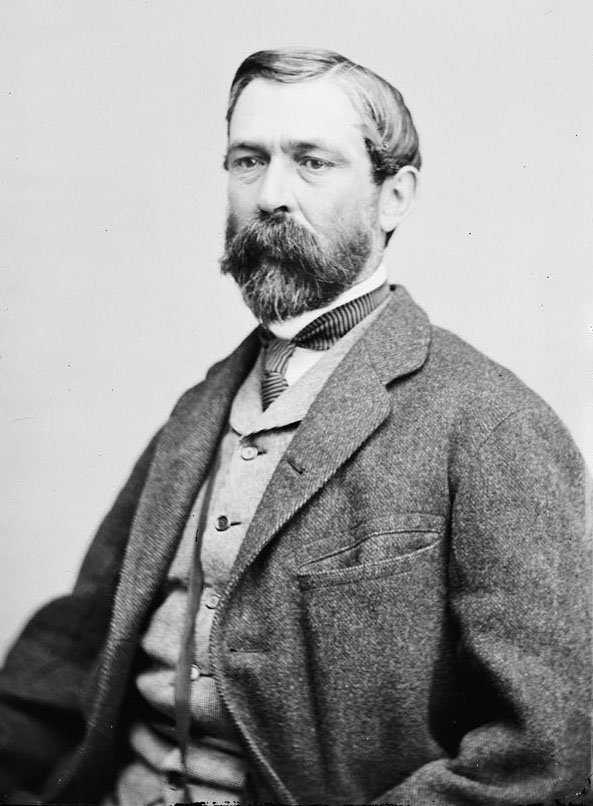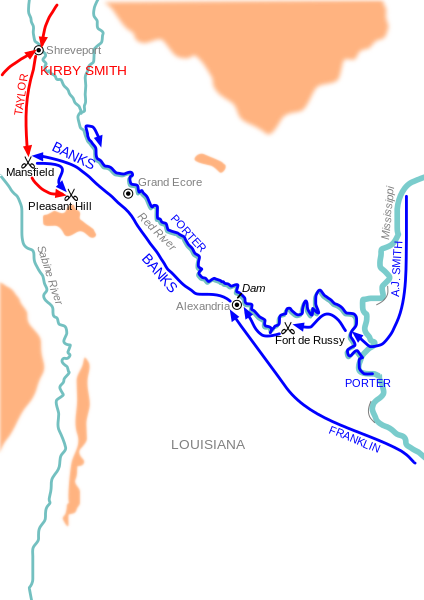As the Union
General Nathaniel Banks attempted to retreat from his disastrous Red
River Campaign, Richard Taylor continued to harass and attack Banks
with his smaller Confederate force. The Federals had already escaped
by the skin of their teeth at Bailey's Dam.150 years ago today the
last battle of the campaign was fought along the Atchafalaya River.
If Banks could cross this river, he would be safe from further
Confederate attacks. But first his engineers had to build a bridge
for the Union army to cross, and in the mean time Taylor arrived. The
Federals went out to attack, and drove the Confederates for a time.
Taylor counterattacked, and the fighting swayed back and forth for
several hours. The fight was eventually brought to an end when the
battlefield caught fire, and both sides withdrew from the fighting.
Although the Confederates were not decisively defeated, they did not
move forward again before Banks crossed the river to safety. In this
fight the Federals lost about 350, the Confederates, 500.
Showing posts with label Red River Campaign. Show all posts
Showing posts with label Red River Campaign. Show all posts
Sunday, May 18, 2014
Battle of Yellow Bayou
Labels:
battle,
campaign,
Louisiana,
Nathaniel Banks,
Red River Campaign,
Richard Taylor
Wednesday, April 30, 2014
Dams Dug on the Red River
 |
| Joseph Bailey |
 |
| Remnants of the dam in 1984 |
 |
| The dam |
 |
| Sailing through the dam |
Labels:
campaign,
David Porter,
Louisiana,
Nathaniel Banks,
Red River Campaign,
river
Battle of Jenkin's Ferry
 |
| Frederick Steele |
The Red River Campaign in western Louisiana was turning into a
disaster for the Union at the end of April, 1864. Frederick Steele's
movement south was stopped at Camden, Arkansas. There he was running
low on supplies, hemmed in by Confederate forces, and two large
foraging expeditions had been badly defeated at Poison Spring and
Mark's Mill. Therefore he ordered his army to fall back on the
morning of April 27. The Confederate army under Sterling Price and
Kirby Smith started after him and rain began to fall, making the
campaigning hard for both sides. The southern cavalry under Fagan,
who had defeated the Federals at Mark's Mill, were unable to destroy
the Federal supply depots, cut off the Union retreat, or even join
Smith in time to take part in the battle that was fought.
 |
| Jenkin's Ferry Battlefield. Source. |
As Price's men continued their pursuit on the morning of April 30th,
they encountered the Federals behind hastily constructed earthworks
near Jenkins' Ferry. Steele had picked a position to stand a fight to
try to halt Price's pursuit. The place was well chosen, as the front
was only 400 yards wide and the flanks were guarded by natural
obstacles that limited Confederate movements. As infantry arrived on
the field, Sterling Price sent them forward to attack the Federal
position. Although it did not take them long to engage the Federals,
the attacks were too uncoordinated to make any progress. The field
was soon covered in smoke, and the Confederate attacks had to be made
over open ground, covered in mud and water.
 |
| Kirby Smith |
After these fruitless assaults, Kirby Smith arrived with a complete
division from Texas, but he sent them in piecemeal, a brigade at a
time. The southerners took heavy casualties, but were unable to break
the Federal line. Finally by 3 pm the Union forces fell back,
bringing with them all the cannon and wagons they could drag out of
the mud. Although Steele had by no means crushed the Confederate
forces, he was successful in slowing the pursuit and giving his men
time to escape. Both sides suffered heavy casualties. The
Confederates reported 443 casualties, but this did not include any
from the Texas division. The Federals reported loosing 521 men, but
this number also is likely incomplete.
Although the Confederates were not able to destroy either Steele's or
Bank's army in the Red River Campaign, it was still an impressive
success. Both expeditions were defeated, and at the end of the
campaign the Confederates detached 20,000 to send to Johnston's army
in Georgia, and prevent 10,000 Federals from joining Sherman on that
front.
 |
| Battlefield Monument. Source. |
Labels:
Arkansas,
battle,
campaign,
Kirby Smith,
Red River Campaign
Friday, April 25, 2014
Battle of Mark's Mill
After advancing to Camden, Arkansas, Union General Frederick Steele
had discovered the Red River Campaign was in shambles, with Banks
retreating back to New Orleans. Steele was running out of supplies,
but a foraging expedition he sent out was crushed at the Battle of
Poison Spring. The Federals were still low on supplies, so Steele
sent out another column to try to bring supplies from Pine Bluff. The
force was made up of 1,800 men under Lieutenant Colonel Francis
Drake. The journey was uneventful until the morning of April 25th,
150 years ago today, when the Yankees were just a few miles from
their destination. However, unbeknownst to the Federals, 5,000
Confederates were not far distant.
 |
| Mark's Mill Battlefield. Source. |
As the Union troops pressed forward they passed empty Confederate
camps. This was reported to Drake, but he ignored the evidence of a
large rebel force in the area, and determined to press on. As the
43rd Indiana, which led the Federal column, entered the
clearing of Mark's Mill, they encountered dismounted Confederate
cavalry. The Union soldiers pushed them back, with the help of the
36th Iowa, but when more Confederates arrived on their
right the tide of battle turned and the Federals fell back through
the clearing. As they fell back they were hit on their left by more
Confederates. With double the enemy's numbers, the Southerners
gradually surrounded a large part of the Federal force. Confederate
General Cabel wrote in his report:
[Our] killed and wounded … show how stubborn the enemy was and how
reluctantly they gave up the train. Men never fought better. They
whipped the best infantry regiments that the enemy had (old veterans,
as they were called), and then in numbers superior to them.
For four hours the battle raged until finally the Federal troops
surrendered who could not escape the encircling greybacks. The Union
lost between 1,100 and 1,600 men, most of whom were captured, the
Confederates 41 killed, 108 wounded, and 144 missing.
 |
| Drake |
Although this had been called the greatest disaster for the Union
arms in the West, it had some good results in the campaign for
Frederick Steele. The Battle of Mark's Mill delayed the Confederate
forces enough to give the main Union body time to make its escape
from Camden.
Labels:
Arkansas,
battle,
campaign,
Red River Campaign
Friday, April 18, 2014
Campaigning in Arkansas
 |
| Plan for the Red River Campaign |
The state of Arkansas did not see much fighting during the Civil War,
compared to states like Virginia and Tennessee, but one battle was
fought there 150 years ago today. The Union plan for the Red River
campaign was for two forces to converge on Shreveport, Louisiana. One
army under Nathaniel Banks coming up from New Orleans, and another
under Richard Steele coming down from Arkansas.
 |
| Steele |
Steele began his movement from Little Rock on March 23, 1864 with
about 8,500 men under his command. The march was not easy. The
Federals were moving through barren country and had to ward off
attacks from Confederate cavalry. Nonetheless they pressed forward,
and reached Camden, Arkansas on April 15. He found no supplies there,
and a few days later received the news that the campaign was in
shambles. Banks had been defeated at Mansfield and was in retreat,
and Confederate forces under Kirby Smith were moving to cut off
Steele's retreat.
 |
| Williams |
The Federals were running low on supplies, so Steele sent out 1,200
men under Colonel James Williams to forage the area for supplies.
They had completed their mission, and were returning with 200 wagons
full of food, when Confederates attacked. Two Confederate divisions
under John Marmaduke and Samuel Maxey struck the Federal column in
the flank and rear at Poison Spring. The Federal party was driven
into a swamp, loosing 300 men and the supplies they had gathered.
This was just the beginning of the disaster which awaited Steele's
expedition.
Labels:
Arkansas,
campaign,
Red River Campaign
Wednesday, April 9, 2014
Battle of Pleasant Hill
 |
| Battle of Pleasant Hill |
After the Battle
of Mansfield on April 8th, the Federals fell back during
the night to a place called Pleasant Hill. Both the Union and
Confederate had new reinforcements that had not fought on the
previous day. On the morning of April 9th, 150 years ago
today, the Confederates advanced, and began skirmishing with the
Federal troops around noon.
 |
| Map of the battlefield |
At 5 pm the main
Confederate attack finally came, with units attacking all along the
Federal line. On the Union right the Confederate attack from Walker's
and Mouton's divisions made little progress. The divisions of
Churchill and Parson, attacking the Union center and left, had more
success. They drove back the Federal lines, but there was no great
panic like that of the previous day. The Federals pushed back and
began regaining their ground. For two hours this hard fighting
continued. As one soldier wrote,
The mingled roar of artillery and musketry; the shouts of the exultant, as volley after volley was fired with fearful effect; the groans of the wounded; the sulphurous smoke, and the day fading into darkness, all tended to heighten the effect of the thrilling scene.Finally the charging Federals were able to drive back the tired Southerners and capture five of their guns, several of which the Union had lost the previous day.
 |
| Taylor |
The losses from
the battle were heavy from both sides. 1,600 Confederates were
killed, wounded or captured. The Federals lost 152 killed, 859
wounded and 495 captured. Richard Taylor had hoped that he could
follow up on his success of the previous day, but his plan had fallen
apart. He had planned to flank the enemy, but Churchill, the general
entrusted with the attack, had not moved far enough to reach the
Union flank. Although this battle was a tactical victory for
Nathaniel Banks, it was a strategic defeat. He ordered his army to
fall back, and abandoned the rest of his plans for the campaign.
Labels:
battle,
campaign,
Louisiana,
Nathaniel Banks,
Red River Campaign,
Richard Taylor
Tuesday, April 8, 2014
Battle of Mansfield
 |
| Map of the Red River Campaign |
In the spring of
1864 the Union Army began a campaign up the Red River in Western
Louisiana. An army under Nathaniel Banks, supported by a flotilla of
gunboats, headed upriver towards Shreveport, LA. The Confederate
commander in the area was Richard Taylor. When he received news of
Banks' advance, he ordered his troops to concentrate at Mansfield.
When Banks drew near the area, he left the immediate support of the
gunboats to fight Taylor there.
 |
| Battle of Mansfield |
At the beginning
of the day the Confederates had 9,000 men on one side of a clearing,
with more reinforcements on the way. Although the Federal army was
much larger, they were still on their way to the battlefield. Both
sides waited during the first part of the day, until finally the
Confederates struck at 4 pm. The Confederate left was repulsed and
many of its commanders killed, but on the right they overlapped the
Union position. The Federal line broke and many prisoners fell into
Confederate hands. A second line was quickly organized, but it too
was overrun by Confederate charges. After pursuing the retreating
Yankees for several miles, the Confederates encountered a third
Federal line, which they were unable to capture before nightfall.
The Union lost 113
killed, 581 wounded and 1,541 captured, along with 20 cannon and many
wagons. The losses of the Confederates were not precisely recorded,
but they were about 1,000 killed and wounded combined.
Labels:
battle,
campaign,
Louisiana,
Nathaniel Banks,
Red River Campaign,
Richard Taylor
Wednesday, March 12, 2014
Red River Campaign Begins
 |
| Red River Campaign |
 |
| Taylor |


